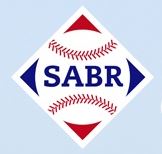
Photo by kelly.sikkema
On this date in 1929, Cleveland Indians’ SS Joe Sewell notched his 115th consecutive game without striking out (the MLB modern record) – a streak that went from May 19-September 19 (the following day, Sewell notched his third strikeout of the season.) During his 115-game streak, Sewell racked up 436 at bats and 143 hits (.328), with 27 doubles, two triples, seven HR and 56 RBI. On the season, Sewell fanned just four times in 578 at bats – and it wasn’t even his best campaign in terms of at bats/per whiff. That would be 1932, when Sewell struck out just three times in 503 at bats – or once each 167.7 at bats (the post-1900 MLB record). For his career, Sewell fanned 114 times in 7,132 at bats – or once each 62.6 at bats. That, by the way, puts Sewell second on the career list (among players who played after 1900) to Wee Willie Keeler who fanned just once every 63.2 at bats in 19 MLB seasons )1892-1910).
Through September 18, 69 players have struck out more times in this season than Joe Sewell did in his entire 14-season career.
By the way, if you are looking for the leader among active players – at the top of the list would be Nationals’ outfielder Ben Revere with 10.11 at bats per strikeout (as of September 18, 2016) – the only active player with more than ten at bats per whiff.
Active Players with the Most At Bats Per Strikeout (as of September 18, 2016)
Ben Revere … 10.11
Yadier Molina … 9.59
Ichiro Suzuki … 9.36
Dustin Pedroia … 9.26
Casey Kotchman … 9.08
Note: Pre-1900 at bat/per strikeout ratios are off the charts. In 1871, for example, catcher Mike McGeary of the National Association’s Troy Haymakers went an entire season (just 148 at bats, however) without a whiff. Later, in 1875, McGeary (with the NA’s Philadelphia Whites) had a season in which he fanned just once in 310 at bats. If you look only at the NL and AL, Wee Willie Keeler holds the record with just two strikeouts in 570 at bats (one K per 285 at bats) for Brooklyn’s 1899 NL squad – a year in which he hit .379, with one home run and 61 RBI.
I tweet baseball @DavidBBRT
Member: Soceity for American Baseball Research (SABR); The Baseball Reliquary; Baseball Bloggers Alliance.
![[George Sisler, University of Michigan (baseball)] (LOC) by The Library of Congress George sisler photo](https://baseballroundtable.com/wp-content/uploads/2016/09/3295492634_9c3a9ce46c_m_George-sisler.jpg)
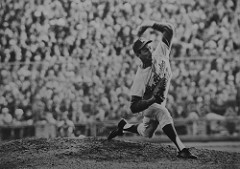

![[Hippo Vaughn, Chicago NL (baseball)] (LOC) by The Library of Congress Hippo Vaughn photo](https://baseballroundtable.com/wp-content/uploads/2016/09/5793151367_cc4614402e_m_Hippo-Vaughn.jpg)
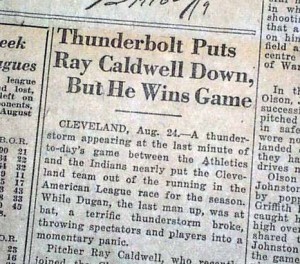 We’ve all seen baseball fans reward a player (with a loud round of applause) for getting up, dusting himself off and trotting to first base after getting hit by a pitch.
We’ve all seen baseball fans reward a player (with a loud round of applause) for getting up, dusting himself off and trotting to first base after getting hit by a pitch.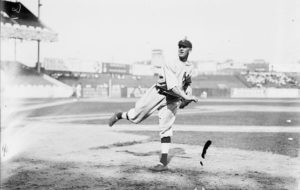


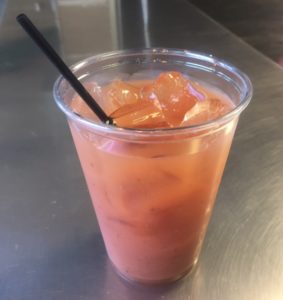
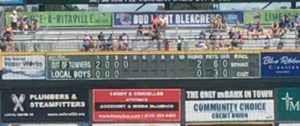




 An additional bit of information on Day Seven – for the full day, click
An additional bit of information on Day Seven – for the full day, click 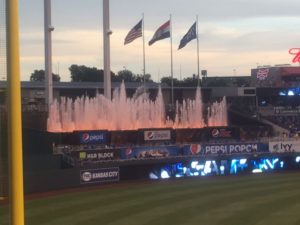 Arriving at Kaufmann Stadium, you first notice the higher level of security (as opposed to all our minor league stops) … bag searches and metal detectors were the order of the day. Once inside the stadium, which opened in 1973 and underwent significant renovation in the late 2000’s, you notice the steep upper deck, massive “Crown Vision” scoreboard/video board in center field and the right field fountain area.
Arriving at Kaufmann Stadium, you first notice the higher level of security (as opposed to all our minor league stops) … bag searches and metal detectors were the order of the day. Once inside the stadium, which opened in 1973 and underwent significant renovation in the late 2000’s, you notice the steep upper deck, massive “Crown Vision” scoreboard/video board in center field and the right field fountain area.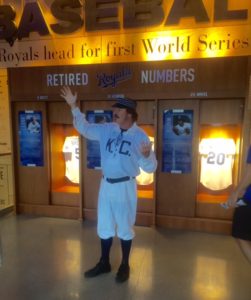
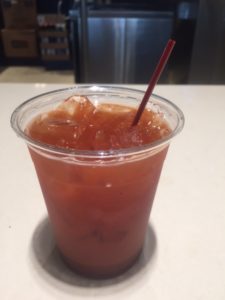 The Bloody Mary – $10 at the Boulevard Pub – was adequate: good pour; spicy, but not over bearing (it could have used a touch more tabasco and a bit of celery salt); it included a lime wedge, but I do like more substance in a Bloody Mary (maybe a celery stick, olives or a pickle spear.) Still at $10, it was a better bargain than the $11 beer. (One of our group reported paying $27 for two beers and a bag of peanuts.)
The Bloody Mary – $10 at the Boulevard Pub – was adequate: good pour; spicy, but not over bearing (it could have used a touch more tabasco and a bit of celery salt); it included a lime wedge, but I do like more substance in a Bloody Mary (maybe a celery stick, olives or a pickle spear.) Still at $10, it was a better bargain than the $11 beer. (One of our group reported paying $27 for two beers and a bag of peanuts.) One popular concession item with our group was the “Berrie Kabob” – available for $7 at a nearby concession stand or from strolling vendors. They consisted of chocolate dipped strawberries, bananas and brownies (in various combinations) on a stick – and were delicious. If you are looking for dessert, this one is a hit.
One popular concession item with our group was the “Berrie Kabob” – available for $7 at a nearby concession stand or from strolling vendors. They consisted of chocolate dipped strawberries, bananas and brownies (in various combinations) on a stick – and were delicious. If you are looking for dessert, this one is a hit.

 hen it was on to check-in at the Read House Historic Inn – originally opened in 1872 and rebuilt in 1926. It boasted beautiful (and historic) rooms, complemented by the most up-to-date amenities. Sitting in the elegant, high-ceilinged, chandeliered lobby, you half expected Winston Churchill of Al Capone – both previous guests – to come strolling in.
hen it was on to check-in at the Read House Historic Inn – originally opened in 1872 and rebuilt in 1926. It boasted beautiful (and historic) rooms, complemented by the most up-to-date amenities. Sitting in the elegant, high-ceilinged, chandeliered lobby, you half expected Winston Churchill of Al Capone – both previous guests – to come strolling in.
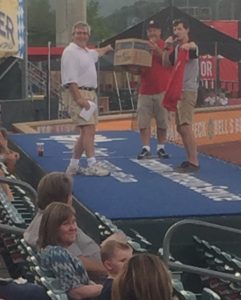
 For those not familiar with it, a Moon Pie is a confection – popular in the southern states – that is basically a portable “s’more.” The traditional Moon Pie consists of two round graham crackers, with marshmallow filling in-between, dipped in chocolate. The dessert has been around since 1917 and, for reasons unknown, there is a southern tradition of washing them down with RC Cola. In fact, at least two musical groups have had minor hits with songs based on the RC Cola/Moon Pie combination. Moon Pies, by the way were born and are still produced by The Chattanooga Bakery. They now come in Chocolate, Caramel, Banana, Vanilla and Strawberry.
For those not familiar with it, a Moon Pie is a confection – popular in the southern states – that is basically a portable “s’more.” The traditional Moon Pie consists of two round graham crackers, with marshmallow filling in-between, dipped in chocolate. The dessert has been around since 1917 and, for reasons unknown, there is a southern tradition of washing them down with RC Cola. In fact, at least two musical groups have had minor hits with songs based on the RC Cola/Moon Pie combination. Moon Pies, by the way were born and are still produced by The Chattanooga Bakery. They now come in Chocolate, Caramel, Banana, Vanilla and Strawberry.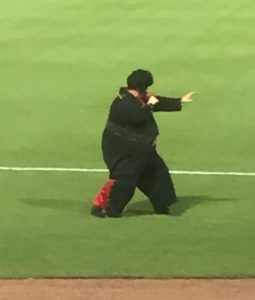



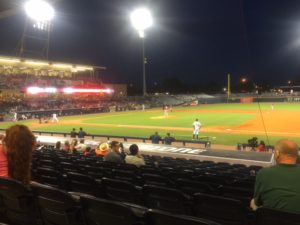 Now, to the game. The Tacoma Raniers were in town – meaning we were seeing two first-place teams (Raniers 71-51, first in the Pacific Coast League Northern Division) and the Sounds 70-53, first in the Southern Division), playing for home field advantage in the upcoming playoffs.
Now, to the game. The Tacoma Raniers were in town – meaning we were seeing two first-place teams (Raniers 71-51, first in the Pacific Coast League Northern Division) and the Sounds 70-53, first in the Southern Division), playing for home field advantage in the upcoming playoffs.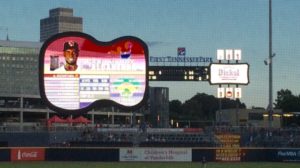
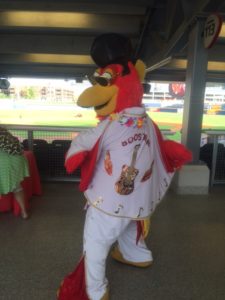
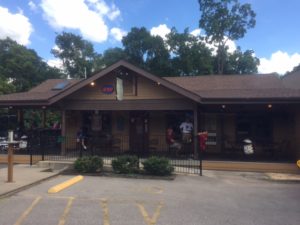
 As the beverages flowed, the smiles on our group expanded (and the volume of the conversation was amplified) – at least until the food began to arrive. Overall, it was a tasty and refreshing stop on our way into Nashville.
As the beverages flowed, the smiles on our group expanded (and the volume of the conversation was amplified) – at least until the food began to arrive. Overall, it was a tasty and refreshing stop on our way into Nashville. First Tennessee Park –which opened in 2015 – is home to the Nashville Sounds. The stadium, which holds 10,000, has very sleek design and, most notably, a unique guitar-shaped scoreboard/video board (a tribute to Nashville as Music City). It has a wide concourse that circles the entire field – offering great views from anywhere. Out in right field, you will find another unique aspect of this ball park – The Band Box, with its full bar and host of free outdoor diversions, including shuffle board, foosball, bean bag games, ping pong and – for a five-dollar fee – miniature golf. There is also ample seating (couches, lounge chairs, bar stools) and a very “I’m on vacation having a good time” vibe. BBRT recommendation: If you get here, go there.
First Tennessee Park –which opened in 2015 – is home to the Nashville Sounds. The stadium, which holds 10,000, has very sleek design and, most notably, a unique guitar-shaped scoreboard/video board (a tribute to Nashville as Music City). It has a wide concourse that circles the entire field – offering great views from anywhere. Out in right field, you will find another unique aspect of this ball park – The Band Box, with its full bar and host of free outdoor diversions, including shuffle board, foosball, bean bag games, ping pong and – for a five-dollar fee – miniature golf. There is also ample seating (couches, lounge chairs, bar stools) and a very “I’m on vacation having a good time” vibe. BBRT recommendation: If you get here, go there.
 First Tennessee Park is located on Junior Gilliam Way. Gilliam – born in Nashville – was an infielder (2B/3B) with the Dodgers from 1953-66; 1953 NL Rookie of the year; a two-time All Star; and key member of seven NL pennant winners (four-time World Series Champions). Before joining the Dodgers, he was a three-time Negro League All Star (Baltimore Elite Giants) and the 1952 International League Most Valuable Player (with Montreal). Considered one of MLB’s true gentleman – and a gamer who gave his all for the team – Gilliam is not only honored by with Nashville’s Junior Gilliam Way, he also has a Los Angeles park named in his honor.
First Tennessee Park is located on Junior Gilliam Way. Gilliam – born in Nashville – was an infielder (2B/3B) with the Dodgers from 1953-66; 1953 NL Rookie of the year; a two-time All Star; and key member of seven NL pennant winners (four-time World Series Champions). Before joining the Dodgers, he was a three-time Negro League All Star (Baltimore Elite Giants) and the 1952 International League Most Valuable Player (with Montreal). Considered one of MLB’s true gentleman – and a gamer who gave his all for the team – Gilliam is not only honored by with Nashville’s Junior Gilliam Way, he also has a Los Angeles park named in his honor. We had good seats once again, down the third base line – and we saw a competitive contest, taken by the Reno Aces (over the Nashville Sounds) 3-2. Shelby Miller – a 15-game winner for the Cardinals in 2013, but sent down after starting 2-9, 7.14 for the Diamondbacks this season – went 7 1/3 innings, giving up just two runs on ten hits. He helped himself out with some key strikeouts (a total of nine K’s versus no walks). Miller, reaching the mid-90s, threw 72 of 100 pitches for strikes. In addition, he got a hand (or arm) from Reno catcher Ronnie Freeman who shut down the Nashville running game, nailing all three Nashville attempted stealers (second, third and fourth innings). The Sounds were, apparently, testing the 25-year-old Freeman, in his first game at AAA since being promoted from AA Mobile. He passed. There was one other attempted steal in the game. This one, by Reno, was thwarted by Nashville catcher Matt McBride. Not a good day on the base paths for either side.
We had good seats once again, down the third base line – and we saw a competitive contest, taken by the Reno Aces (over the Nashville Sounds) 3-2. Shelby Miller – a 15-game winner for the Cardinals in 2013, but sent down after starting 2-9, 7.14 for the Diamondbacks this season – went 7 1/3 innings, giving up just two runs on ten hits. He helped himself out with some key strikeouts (a total of nine K’s versus no walks). Miller, reaching the mid-90s, threw 72 of 100 pitches for strikes. In addition, he got a hand (or arm) from Reno catcher Ronnie Freeman who shut down the Nashville running game, nailing all three Nashville attempted stealers (second, third and fourth innings). The Sounds were, apparently, testing the 25-year-old Freeman, in his first game at AAA since being promoted from AA Mobile. He passed. There was one other attempted steal in the game. This one, by Reno, was thwarted by Nashville catcher Matt McBride. Not a good day on the base paths for either side.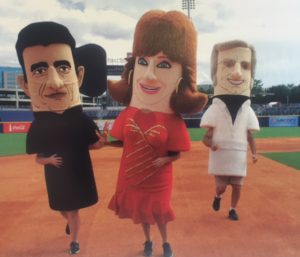 There were mixed feelings about the Nashville Sound Wave (cheerleaders/dance line). Some of our group questioned whether baseball needs cheerleaders. I’ll stay out of that one. Everyone seemed to like the racing country stars – Johnny Cash, Reba and George Jones.
There were mixed feelings about the Nashville Sound Wave (cheerleaders/dance line). Some of our group questioned whether baseball needs cheerleaders. I’ll stay out of that one. Everyone seemed to like the racing country stars – Johnny Cash, Reba and George Jones.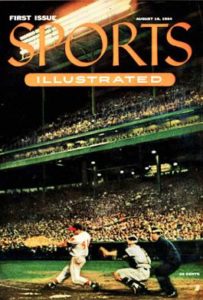 On this date (August 16) in 1954, the first issue of Sports Illustrated hit the newsstands. One the cover was BBRT’s favorite player of all time, Braves’ third baseman Eddie Mathews. The Braves’ third sacker – known as a basher (512 career home runs) and a brawler (he had some memorable conflicts with players like Don Drysdale and Frank Robinson) – was pictured hitting a home run. He would appear on the cover again in June of 1958 and August of 1994 (40th Anniversary Issue).
On this date (August 16) in 1954, the first issue of Sports Illustrated hit the newsstands. One the cover was BBRT’s favorite player of all time, Braves’ third baseman Eddie Mathews. The Braves’ third sacker – known as a basher (512 career home runs) and a brawler (he had some memorable conflicts with players like Don Drysdale and Frank Robinson) – was pictured hitting a home run. He would appear on the cover again in June of 1958 and August of 1994 (40th Anniversary Issue). Day Three of Ballpark Tours XXXIV sees us remaining in Memphis, with a second Tacoma Raniers/Memphis Redbirds game slated for 6:05 p.m.
Day Three of Ballpark Tours XXXIV sees us remaining in Memphis, with a second Tacoma Raniers/Memphis Redbirds game slated for 6:05 p.m. Being as major fan of the blues, I headed toward the Beale Street Entertainment District, where the barbeque is sweet and the live music starts at 11 a.m. and runs straight through to 3 a.m. It’s also where I saw quite a few of my fellow tour participants. I stopped to take in a few tunes at a handful of clubs before heading for lunch at my previously selected destination – B.B. King’s Blues Club. I could not miss visiting the original B.B. King’s location. I was not disappointed. The house band was great – back in Minnesota they’d be headliners – and so were the Memphis-style dry-rub ribs. I hung out at B.B. King’s for a couple of hours (or a couple of brews, depending on how you measure) before heading over to Autozone Park for the evening’s ball game (6:05 p.m. start),
Being as major fan of the blues, I headed toward the Beale Street Entertainment District, where the barbeque is sweet and the live music starts at 11 a.m. and runs straight through to 3 a.m. It’s also where I saw quite a few of my fellow tour participants. I stopped to take in a few tunes at a handful of clubs before heading for lunch at my previously selected destination – B.B. King’s Blues Club. I could not miss visiting the original B.B. King’s location. I was not disappointed. The house band was great – back in Minnesota they’d be headliners – and so were the Memphis-style dry-rub ribs. I hung out at B.B. King’s for a couple of hours (or a couple of brews, depending on how you measure) before heading over to Autozone Park for the evening’s ball game (6:05 p.m. start), It was another heavy, humid day – with storms predicted –which may have contributed to the very small crowd (as might the Redbirds sub-.500 record). We did not, however, get rained on. The announced attendance was 3,517, but I’d be surprised if there were more than 2,500. – and they were a quiet bunch, despite Memphis’ 6-2 win. We tried to get something going, but often all you heard was the “sound of one fan clapping.” Good seats again, by the way, third-base side this time.
It was another heavy, humid day – with storms predicted –which may have contributed to the very small crowd (as might the Redbirds sub-.500 record). We did not, however, get rained on. The announced attendance was 3,517, but I’d be surprised if there were more than 2,500. – and they were a quiet bunch, despite Memphis’ 6-2 win. We tried to get something going, but often all you heard was the “sound of one fan clapping.” Good seats again, by the way, third-base side this time.